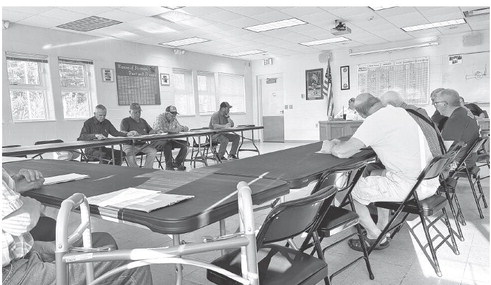County committee hears update on road safety efforts
Roads in Taylor County were more dangerous this past summer.
On Tuesday, Todd Rasmussen a consultant who works as the law enforcement liaison with the Department of Transportation, reported to members of the county’s traffic safety committee that there have been 91 crashes in the past three months on Taylor County roads, this is up 5% from the three-year average of 86 crashes over the summer months. While Taylor County is up for the summer, at the state level the number of crashes statewide is just below the five year average. Unfortunately the number of fatalities is up statewide compared to the five-year average. Locally, Taylor County had one reported fatality on county roads, that was from a one-vehicle crash in June.
There were 19 crashes that involved injuries with four where there were suspected severe injuries. Of the crashes, 11 involved teen drivers and nine involved drivers age 65 over older.
In two of the crashes in recent months, injuries were aggravated by lack of seat belt use. While in another injury-causing crash, lack of bicycle lighting on an e-bike was a contributing factor.
Committee members also received an overview of the efforts at the state level to raise awareness of and combat wrong-way driver crashes. These are crashes on divided four-lane highways where motorists go against the flow of traffic. Rasmussen explained that these happen most frequently at side by side on ramps and, not surprisingly, result in a more serious injuries than other types of highway crashes.
According to Rasmussen, the statistics show that wrong way drivers are more likely to be impaired or seniors. Between 2012 and January 2025, there have been 4,500 wrong way driver incidents.
To combat this, the state is taking additional measures where signs are being placed and installing flashing wrong-way signs and more reflective signs. He noted that drunk or impaired drivers typically look down the hood of their vehicles rather than higher up and so the state is beginning to hang the wrong-way signs lower on the posts than normal height.
In addition, he said there are sensors that can be added to ramps to alert law enforcement when vehicles have entered a highway going the wrong direction. However, Rasmussen noted these cost about $100,000 per ramp. He said the closest one he is aware of will be installed in Wausau.
Rasmussen also reported on the recent program to allow law enforcement officers to become trained to take their own blood tests for impaired drivers. He said the state this year offered three classes for this in the past year and 20 agencies participated. Since August 2024 he said there have been 120 blood draws by law enforcement personnel.
For the agencies involved, having officers do the blood draws had greatly sped up the time for processing from the one to three hours that it took before to as fast as 20 to 30 minutes to process an impaired driver. He said additional classes will be offered in January and May next year.
Rasmussen also reported that motorists are now able to add an emergency contact to their driver’s license. He said this is protected information that is not released to the public, and that as people get their licenses renewed they will be asked to add a contact name and phone number. He said people may do this on their own at any time by going to the Department of Transportation website.
Rasmussen also updated committee members on legislation related to traffic safety. Changes include increasing the physical requirements for school bus drivers to have to have a physical every four years after age 70 rather than two years. He said this is due to the lack of school bus operators. There is also a change to mandate that proper stopping for school buses loading and unloading passengers be included in driver’s safety training. Another change would be to require drivers to pull over and slow down for any disabled vehicles on the side of the road. This would mirror rules for emergency vehicles.
Rasmussen said one proposal that he anticipated would become law would be to allow state and local agencies to begin installing speed cameras and red light cameras and issue tickets from them. He said the idea has been proposed in the past in Wisconsin but has never passed into law, however, with this legislation specifically limited to the city of Milwaukee (as the only Class 1 city in the state) it has a greater likelihood of being passed. He said he would look at it as being a trial run for the rest of the state. On a practical sense, however, the bill limits when tickets can be issued based on the cameras.
County highway commissioner Ben Stanfley, who was chairing the meeting, reported the recent action taken by the county to make the CTH E and CTH A intersection a four-way stop to try and improve safety.


